Saprophytic Orchids of Dallas
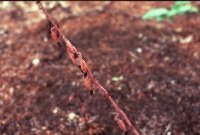 IN THE SUMMER of 1981, I was wandering around the escarpment of southwest
Dallas, Texas, in search of something photogenic to put on the last half of a roll
of film so I could send it off to be developed. My wanderings brought me to a
grove of junipers and oaks. After looking around for a while, I noticed something
that looked at first glance like an orchid.
I did not know there were any orchids in
the Dallas area, so I was quite surprised. On closer inspection, it was clear that I
was looking at the stem of an orchid plant laden with seed capsules. There were no
leaves or open flowers on the plant. I looked around for others but found none
except a smaller plant growing right beside the first one. When I got home, I looked
through one of my orchid books and concluded that what I had found was probably
a species of Corallorhiza.
IN THE SUMMER of 1981, I was wandering around the escarpment of southwest
Dallas, Texas, in search of something photogenic to put on the last half of a roll
of film so I could send it off to be developed. My wanderings brought me to a
grove of junipers and oaks. After looking around for a while, I noticed something
that looked at first glance like an orchid.
I did not know there were any orchids in
the Dallas area, so I was quite surprised. On closer inspection, it was clear that I
was looking at the stem of an orchid plant laden with seed capsules. There were no
leaves or open flowers on the plant. I looked around for others but found none
except a smaller plant growing right beside the first one. When I got home, I looked
through one of my orchid books and concluded that what I had found was probably
a species of Corallorhiza.
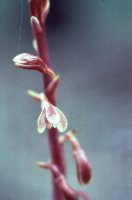 In August of 1982, I went back to the same place
to see if the plant had come up
again. Unfortunately, it had not. So I looked around the
immediate area for other
plants. It was not long before I found about a dozen plants full of flower buds and
developing ovaries. Only one plant had an open flower, and that flower was open
only partially. I looked through several orchid books to try to identify the orchid,
but I could not find any matches. Any plant that looked remotely like the right
species had a range that did not include the Dallas area.
In August of 1982, I went back to the same place
to see if the plant had come up
again. Unfortunately, it had not. So I looked around the
immediate area for other
plants. It was not long before I found about a dozen plants full of flower buds and
developing ovaries. Only one plant had an open flower, and that flower was open
only partially. I looked through several orchid books to try to identify the orchid,
but I could not find any matches. Any plant that looked remotely like the right
species had a range that did not include the Dallas area.
The following year, I started sooner in my search for the plants in order to catch
them in an earlier stage of development. However, instead of finding immature
inflorescences of the same species, I found another species in full bloom. I sent a
specimen to the Orchid Identification Center at the Marie Selby Botanical Gardens
in Sarasota, Florida, and the plant was identified as Corallorhiza wisteriana, a fairly
widespread species whose range includes the Dallas area.
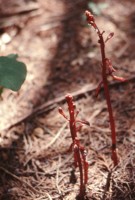 The plants I originally was looking for did not come up that year at all. It wasn't
until July of 1986 that they came up again. This time, I dissected one of the flowers
to try to make a proper identification. I noticed that instead of having four pollinia,
as corallorhizas do, it had eight. By that time, I was somewhat familiar with the
genus Hexalectris, so I concluded that the plant was a species of that genus. The size
and shape of the flowers when spread out flat indicated that the plant was Hexalectris
nitida. However, the range was wrong. Hexalectris nitida had been reported only in
Panther Hill in the Glass Mountains of Brewster County, Texas, and in the Sierra
Mojada in the state of Coahuila, Mexico. There were some other problems. In
Carlyle A. Luer's The Native Orchids of the United States and Canada Excluding Florida,
Hexalectris nitida was described as having open flowers with sepals and petals curving
backward toward the stem. The plants in Dallas very rarely had open flowers.
Another difference was that according to Luer, there were five ridges on the
tip of the lip's mid-lobe. The plants in Dallas had five ridges on the lip, but the ridges were
not at the tip. Because of the differences, I sent a specimen to the O.I.C. for
identification. Soon I got a reply confirming that the plant was an autogamous form
of Hexalectris nitida.
The plants I originally was looking for did not come up that year at all. It wasn't
until July of 1986 that they came up again. This time, I dissected one of the flowers
to try to make a proper identification. I noticed that instead of having four pollinia,
as corallorhizas do, it had eight. By that time, I was somewhat familiar with the
genus Hexalectris, so I concluded that the plant was a species of that genus. The size
and shape of the flowers when spread out flat indicated that the plant was Hexalectris
nitida. However, the range was wrong. Hexalectris nitida had been reported only in
Panther Hill in the Glass Mountains of Brewster County, Texas, and in the Sierra
Mojada in the state of Coahuila, Mexico. There were some other problems. In
Carlyle A. Luer's The Native Orchids of the United States and Canada Excluding Florida,
Hexalectris nitida was described as having open flowers with sepals and petals curving
backward toward the stem. The plants in Dallas very rarely had open flowers.
Another difference was that according to Luer, there were five ridges on the
tip of the lip's mid-lobe. The plants in Dallas had five ridges on the lip, but the ridges were
not at the tip. Because of the differences, I sent a specimen to the O.I.C. for
identification. Soon I got a reply confirming that the plant was an autogamous form
of Hexalectris nitida.
In Dallas, Hexalectris nitida seems to prefer living in the leaf litter of a mixed
juniper and oak forest. Although I have seen some plants in oak litter, the vast
majority prefer a bed of decaying juniper needles below which is limestone bedrock.
Although all the plants seen were growing near the escarpment, they did not grow past the edge.
Presumably, this is because moisture cannot accumulate very well on
the sloped surfaces of the escarpment. Also, the soil is not as thick on the slanted
surfaces.
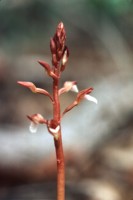 Corallorhiza wisteriana grows in the smae forest as Hexalectris nitida.
However, Corallorhiza wisteriana prefers forest dominated by oaks, whereas Hexalectris nitida
prefers junipers. Corallorhiza wisteriana also grows in poorer, sandy soil that is
populated by grasses. Plants growing in these areas were always smaller than the
ones growing in oak litter. Corallorhiza wisteriana also seems more tolerant of
sunlight. Plants frequently are seen in clearings in the forest.
Corallorhiza wisteriana grows in the smae forest as Hexalectris nitida.
However, Corallorhiza wisteriana prefers forest dominated by oaks, whereas Hexalectris nitida
prefers junipers. Corallorhiza wisteriana also grows in poorer, sandy soil that is
populated by grasses. Plants growing in these areas were always smaller than the
ones growing in oak litter. Corallorhiza wisteriana also seems more tolerant of
sunlight. Plants frequently are seen in clearings in the forest.
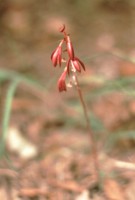 Another saprophytic species previously unknown in this area is Hexalectris
warnockii. When I found the original plant of Hexalectris nitida in 1981, I told Dale
Williams, an orchid grower who lived near the location of the orchids. I asked him if
he had ever seen any native orchids in the area, and he said that he had not. My
discovery piqued his curiosity, and after he saw the plant that I found, he kept his
eye out for orchids in a neighboring property that was downwind from the plant
that was blooming. In the summer of 1986, he was rewarded not only with many
plants of Hexalectris nitida but also with a new, showy species, Hexalectris warnockii.
This species was known to have occurred in parts of central Texas as well as the Big
Bend area in Brewster County. Thus, Williams' discovery constitutes an extensionof the previous range.
Another saprophytic species previously unknown in this area is Hexalectris
warnockii. When I found the original plant of Hexalectris nitida in 1981, I told Dale
Williams, an orchid grower who lived near the location of the orchids. I asked him if
he had ever seen any native orchids in the area, and he said that he had not. My
discovery piqued his curiosity, and after he saw the plant that I found, he kept his
eye out for orchids in a neighboring property that was downwind from the plant
that was blooming. In the summer of 1986, he was rewarded not only with many
plants of Hexalectris nitida but also with a new, showy species, Hexalectris warnockii.
This species was known to have occurred in parts of central Texas as well as the Big
Bend area in Brewster County. Thus, Williams' discovery constitutes an extensionof the previous range.
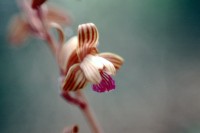 Another saprophytic species reported in the area in 1986 is Hexalectris spicata.
Although I have not seen any plants myself [since the article was published in the bulletin, I have seen many, including the one pictured], they have been seen at the Fort Worth
Nature Center in Fort Worth, Texas.
Another saprophytic species reported in the area in 1986 is Hexalectris spicata.
Although I have not seen any plants myself [since the article was published in the bulletin, I have seen many, including the one pictured], they have been seen at the Fort Worth
Nature Center in Fort Worth, Texas.
As far as I can determine, nobody knows for sure what prompts these saprophytic
species to bloom. One year they may have hundreds of flowers and the next year
none. Therefore, I have accumulated weather data for the years 1980-1986 in an
attempt to correlate blooming with temperature and rainfall. From this information,
it seems clear that generous rainfall in the late spring is necessary for flowering
of Hexalectris nitida. Similarly, early spring rains are required for the blooming of
Corallorhiza wisteriana. This corresponds nicely to the blooming times of March to
May for Corallorhiza wisteriana and July to September for Hexalectris nitida.
I have not yet established a correlation with the temperature.
Go back to Victor Engel's home page.
 IN THE SUMMER of 1981, I was wandering around the escarpment of southwest
Dallas, Texas, in search of something photogenic to put on the last half of a roll
of film so I could send it off to be developed. My wanderings brought me to a
grove of junipers and oaks. After looking around for a while, I noticed something
that looked at first glance like an orchid.
I did not know there were any orchids in
the Dallas area, so I was quite surprised. On closer inspection, it was clear that I
was looking at the stem of an orchid plant laden with seed capsules. There were no
leaves or open flowers on the plant. I looked around for others but found none
except a smaller plant growing right beside the first one. When I got home, I looked
through one of my orchid books and concluded that what I had found was probably
a species of Corallorhiza.
IN THE SUMMER of 1981, I was wandering around the escarpment of southwest
Dallas, Texas, in search of something photogenic to put on the last half of a roll
of film so I could send it off to be developed. My wanderings brought me to a
grove of junipers and oaks. After looking around for a while, I noticed something
that looked at first glance like an orchid.
I did not know there were any orchids in
the Dallas area, so I was quite surprised. On closer inspection, it was clear that I
was looking at the stem of an orchid plant laden with seed capsules. There were no
leaves or open flowers on the plant. I looked around for others but found none
except a smaller plant growing right beside the first one. When I got home, I looked
through one of my orchid books and concluded that what I had found was probably
a species of Corallorhiza. In August of 1982, I went back to the same place
to see if the plant had come up
again. Unfortunately, it had not. So I looked around the
immediate area for other
plants. It was not long before I found about a dozen plants full of flower buds and
developing ovaries. Only one plant had an open flower, and that flower was open
only partially. I looked through several orchid books to try to identify the orchid,
but I could not find any matches. Any plant that looked remotely like the right
species had a range that did not include the Dallas area.
In August of 1982, I went back to the same place
to see if the plant had come up
again. Unfortunately, it had not. So I looked around the
immediate area for other
plants. It was not long before I found about a dozen plants full of flower buds and
developing ovaries. Only one plant had an open flower, and that flower was open
only partially. I looked through several orchid books to try to identify the orchid,
but I could not find any matches. Any plant that looked remotely like the right
species had a range that did not include the Dallas area. The plants I originally was looking for did not come up that year at all. It wasn't
until July of 1986 that they came up again. This time, I dissected one of the flowers
to try to make a proper identification. I noticed that instead of having four pollinia,
as corallorhizas do, it had eight. By that time, I was somewhat familiar with the
genus Hexalectris, so I concluded that the plant was a species of that genus. The size
and shape of the flowers when spread out flat indicated that the plant was Hexalectris
nitida. However, the range was wrong. Hexalectris nitida had been reported only in
Panther Hill in the Glass Mountains of Brewster County, Texas, and in the Sierra
Mojada in the state of Coahuila, Mexico. There were some other problems. In
Carlyle A. Luer's The Native Orchids of the United States and Canada Excluding Florida,
Hexalectris nitida was described as having open flowers with sepals and petals curving
backward toward the stem. The plants in Dallas very rarely had open flowers.
Another difference was that according to Luer, there were five ridges on the
tip of the lip's mid-lobe. The plants in Dallas had five ridges on the lip, but the ridges were
not at the tip. Because of the differences, I sent a specimen to the O.I.C. for
identification. Soon I got a reply confirming that the plant was an autogamous form
of Hexalectris nitida.
The plants I originally was looking for did not come up that year at all. It wasn't
until July of 1986 that they came up again. This time, I dissected one of the flowers
to try to make a proper identification. I noticed that instead of having four pollinia,
as corallorhizas do, it had eight. By that time, I was somewhat familiar with the
genus Hexalectris, so I concluded that the plant was a species of that genus. The size
and shape of the flowers when spread out flat indicated that the plant was Hexalectris
nitida. However, the range was wrong. Hexalectris nitida had been reported only in
Panther Hill in the Glass Mountains of Brewster County, Texas, and in the Sierra
Mojada in the state of Coahuila, Mexico. There were some other problems. In
Carlyle A. Luer's The Native Orchids of the United States and Canada Excluding Florida,
Hexalectris nitida was described as having open flowers with sepals and petals curving
backward toward the stem. The plants in Dallas very rarely had open flowers.
Another difference was that according to Luer, there were five ridges on the
tip of the lip's mid-lobe. The plants in Dallas had five ridges on the lip, but the ridges were
not at the tip. Because of the differences, I sent a specimen to the O.I.C. for
identification. Soon I got a reply confirming that the plant was an autogamous form
of Hexalectris nitida.
 Corallorhiza wisteriana grows in the smae forest as Hexalectris nitida.
However, Corallorhiza wisteriana prefers forest dominated by oaks, whereas Hexalectris nitida
prefers junipers. Corallorhiza wisteriana also grows in poorer, sandy soil that is
populated by grasses. Plants growing in these areas were always smaller than the
ones growing in oak litter. Corallorhiza wisteriana also seems more tolerant of
sunlight. Plants frequently are seen in clearings in the forest.
Corallorhiza wisteriana grows in the smae forest as Hexalectris nitida.
However, Corallorhiza wisteriana prefers forest dominated by oaks, whereas Hexalectris nitida
prefers junipers. Corallorhiza wisteriana also grows in poorer, sandy soil that is
populated by grasses. Plants growing in these areas were always smaller than the
ones growing in oak litter. Corallorhiza wisteriana also seems more tolerant of
sunlight. Plants frequently are seen in clearings in the forest.
 Another saprophytic species previously unknown in this area is Hexalectris
warnockii. When I found the original plant of Hexalectris nitida in 1981, I told Dale
Williams, an orchid grower who lived near the location of the orchids. I asked him if
he had ever seen any native orchids in the area, and he said that he had not. My
discovery piqued his curiosity, and after he saw the plant that I found, he kept his
eye out for orchids in a neighboring property that was downwind from the plant
that was blooming. In the summer of 1986, he was rewarded not only with many
plants of Hexalectris nitida but also with a new, showy species, Hexalectris warnockii.
This species was known to have occurred in parts of central Texas as well as the Big
Bend area in Brewster County. Thus, Williams' discovery constitutes an extensionof the previous range.
Another saprophytic species previously unknown in this area is Hexalectris
warnockii. When I found the original plant of Hexalectris nitida in 1981, I told Dale
Williams, an orchid grower who lived near the location of the orchids. I asked him if
he had ever seen any native orchids in the area, and he said that he had not. My
discovery piqued his curiosity, and after he saw the plant that I found, he kept his
eye out for orchids in a neighboring property that was downwind from the plant
that was blooming. In the summer of 1986, he was rewarded not only with many
plants of Hexalectris nitida but also with a new, showy species, Hexalectris warnockii.
This species was known to have occurred in parts of central Texas as well as the Big
Bend area in Brewster County. Thus, Williams' discovery constitutes an extensionof the previous range.
 Another saprophytic species reported in the area in 1986 is Hexalectris spicata.
Although I have not seen any plants myself [since the article was published in the bulletin, I have seen many, including the one pictured], they have been seen at the Fort Worth
Nature Center in Fort Worth, Texas.
Another saprophytic species reported in the area in 1986 is Hexalectris spicata.
Although I have not seen any plants myself [since the article was published in the bulletin, I have seen many, including the one pictured], they have been seen at the Fort Worth
Nature Center in Fort Worth, Texas.